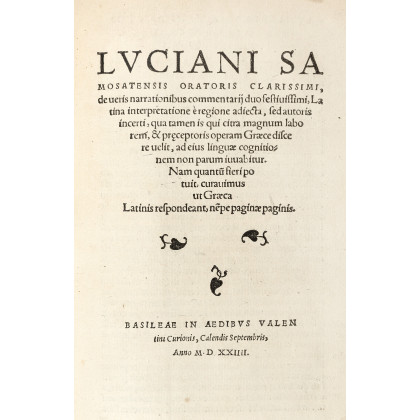
Lot n° 171 | Auction 471
Estimate € 1,000 - 1,500
Sold € 1,100
Auction: 21 January 2020 at 15:00
LUCIANO DI SAMOSATA (120-192 d.C.) - De Veris Narrationibus commentarii duo. Basilea: eredi di Valentino Curione, 1524 - [LEGATO DOPO:] ORFEO. Orphei poetarum vetustissimi Argonauticon opus graecum. Basilea: Andrea Cratandri, 1523. The First Account in Literature of a Trip to the Moon. First separate edition in the original Greek of the True Story, the first account in literature of a trip to the Moon, by the second-century A.D. Syrian-Greek satirist Lucian of Samosata. In this first-person narrative the author sets sail with a crew of fifty companions from the Straits of Gibraltar, intending to sail across the Atlantic, but is swept away by a storm for seven days and seven nights, eventually landing on the moon; there the travelers observe the first interplanetary war in literature, fought between the "Selenitai" (People of the Moon) and the "Heliotai" (People of the Sun) over colonization rights to the Morning Star. The combatants, in true science-fantasy fashion, consist of fanciful creatures that are the spiritual ancestors of those found in Flash Gordon, Star Wars, and Star Trek: "Hippogypoi" (Vulture-Knights), "Hippomyrmekoi" (Ant-Knights), "Skorodomachoi" (Garlic-Fighters), "Psyllotoxotai" (Flea-Archers), "Lachanopteroi" (The Vegetable-Winged), "Anemodromoi" (Wind-Gliders), "Nephelokentauroi" (Cloud-Centaurs), etc.Lucian's intent was to parody the poets, historians, and philosophers who wrote about fabulous places they had never visited and exotic creatures they had never seen. Some scholars have detected in Lucian's True Story influences of versions of the tales found in the Arabian Nights, which may have been current in Lucian's native Syria; indeed, some of the elements in the True Story, such as the 150-mile-long sea-monster that swallows Lucian's ship, and the giant kingfisher, have much in common with, respectively, the huge fish of the Seventh Voyage of Sindbad, and the Roc in the Second Voyage. Lucian's True Story exerted its own, long influence, directly or indirectly, on such storytellers as Rabelais, Cervantes, Cyrano de Bergerac, and Swift; a notorious direct borrower from Lucian's True Story was Rudolf Eric Raspe (1737-1794), whose tall tales based on Baron Munchausen (1785), included a narrative of Munchausen's visit to the moon.The True Story had appeared three times before in Greek as part of Lucian's complete works: Florence 1496, Venice 1503 and 1522. The present edition, the earliest separately printed in the original Greek, is accompanied by an anonymous literal Latin translation intended (as stated in the title) "to assist students in learning Greek without great effort and without a teacher"." Orpheus' work is the first separate edition of the Greek text. 2 works in one volume, 8vo (200 x 145mm). Luciano's work with woodcut decorations on title, Orpheus' with title within woodcut border by Holbein; both with text in Greek and Latin, woodcut decorated initials and large printer's device at end (some light waterstaining to bottom margin and occasional browning). 19th-century marbled boards backed in sheep (extremities rubbed and corners bumped). VD 16, L 3056; Hoffmann II, 547 e III, 31; Hieronymus, Griechischer Geist aus Basler Pressen, 33 e 157; not in BL, not in Adams; see Locke, Voyages in Space, p. 11 ("The earliest surviving interplanetary romance").
Estimate € 1,000 - 1,500


